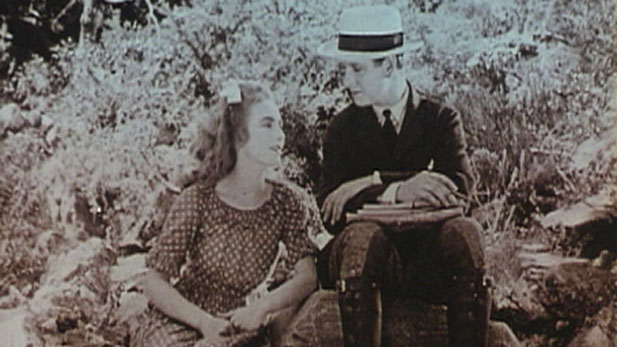 Up until the time Hollywood discovered Tucson the economy was limited. However, when moving pictures became a part of the local scene they changed Tucson in a profound way.
Up until the time Hollywood discovered Tucson the economy was limited. However, when moving pictures became a part of the local scene they changed Tucson in a profound way.
“And it was really one of the first films shot on location in southern Arizona that celebrated the dynamic character of the Sonoran desert as an exotic backdrop,” says Clinco. “The film is incredibly beautiful and has all these cinematic tones and qualities that articulate and celebrate our desert.”
Earlier that year, in 1924, Hollywood movie moguls brought dozens of cast members to Tucson to shoot the Mine with the Iron Door, a story based on the novel by Harold Bell Wright. The drama that unfolded caused a sensation in the town of 20,000 people. The Arizona Daily Star devoted its entire edition to the movie, ads and all. Cast members and crew took up residence at the Triangle and Linda Vista ranches, that until that time, hosted mostly bovine guests. Chuck Sternberg, who moved to the Linda Vista in 1968, and currently directs the Oracle Historical society, says a lack of rainfall, and the urging by Wright, convinced the ranchers to diversify, and the Linda Vista became the first dude ranch in Southern Arizona.
“The Linda Vista was a big cattle ranch. It had 2000 acres, mostly leased land, and that’s where they made their money,” says Sternberg. “Well they didn’t make much money. They started the guest ranch right when the movie was made because there had been a big drought and they thought they were going to go out of business.”
Wright himself spent time at the Canada del Oro, living a practically hermit like existence while writing the Mine with the Iron Door. Though you could hardly call him reclusive. The best selling author wrote nineteen novels in the years between 1903 and 1942, selling 10 million copies. At his insistence Hollywood came to Tucson to shoot the story in its authentic setting.
“The Tucson community saw that this film could become a harbinger of economic prosperity and tourism, and for the fist time Tucson was going to be exposed to an international market,” Clinco explains. Harold Bell Wright who wrote the book that the film is based on was really integral in making sure that the film company came to Tucson, and executed his vision of where these places were that he had written about and really celebrated Tucson as a destination.”
The Tucson community celebrated the movie making as well as the contributions of Wright who lived here for fifteen years, and built his own homestead in the area of Speedway and Wilmot. At that time the property stood five miles out of town along the dusty artery, and became a mecca for visiting artists and scholars. He also contributed his considerable talents to civic activity.
“He was involved in the development of the Temple of Music and Art and really saw the potential of Tucson as a great American city. He worked really hard to celebrate those attributes of our community and push our city into the next decade,” Clinco says. “Ultimately our community became the center of western filmmaking for America in the 20th century and Old Tucson and all of the films shot in the region really. This film was a foreshadowing of that.”
Production of the Mine with the Iron Door ultimately launched Tucson as the the center of western filmmaking for the country, and hinted at what would follow in the region. Before its export to the rest of the world the film premiered at the Rialto, at the time a fledgling four year old movie palace, with non stop showings to thrill the locals. Unfortunately, Antonio Felix, one of only a very few locals hired as extras, had every intention to attend, but met with an insurmountable obstacle on the way to the premiere.
Sternberg laughs when he recollects the account.
“He got a hold of a bottle of whiskey and he had to be put under a bridge because he was passed out. I’m assuming the Rillito because that was probably the only bridge. So he never got to see himself in the movie and he said I’m never going to have another drink, but that was untrue.”
Now Tucson patrons will have the opportunity to discover the old west again as the film reappears at the Rialto on the event of the theatre's 90th birthday. The original showing in 1924 contributed proceeds to the Comstock foundation to support the care of tuberculosis patients who sought the healthful cure of the desert. In fact, that ailment brought Wright here himself, and at the time 25% of the population shared the same affliction. The screenings this autumn will benefit both the Rialto and the Foundation that Clinco directs.
“Without dynamic, wonderful neighborhoods and places, we are less competitive against other cities of the same size, so historic preservation matters. It’s important we find great examples like the Rialto that have adaptively reused buildings to make them vital and important in our contemporary climate,” Clinco says.
The movie that celebrates melodramatic themes of heroism and love will have live accompaniment by musicians performing an original score, and perhaps, those who go will see themselves in the pictures as well.

By submitting your comments, you hereby give AZPM the right to post your comments and potentially use them in any other form of media operated by this institution.